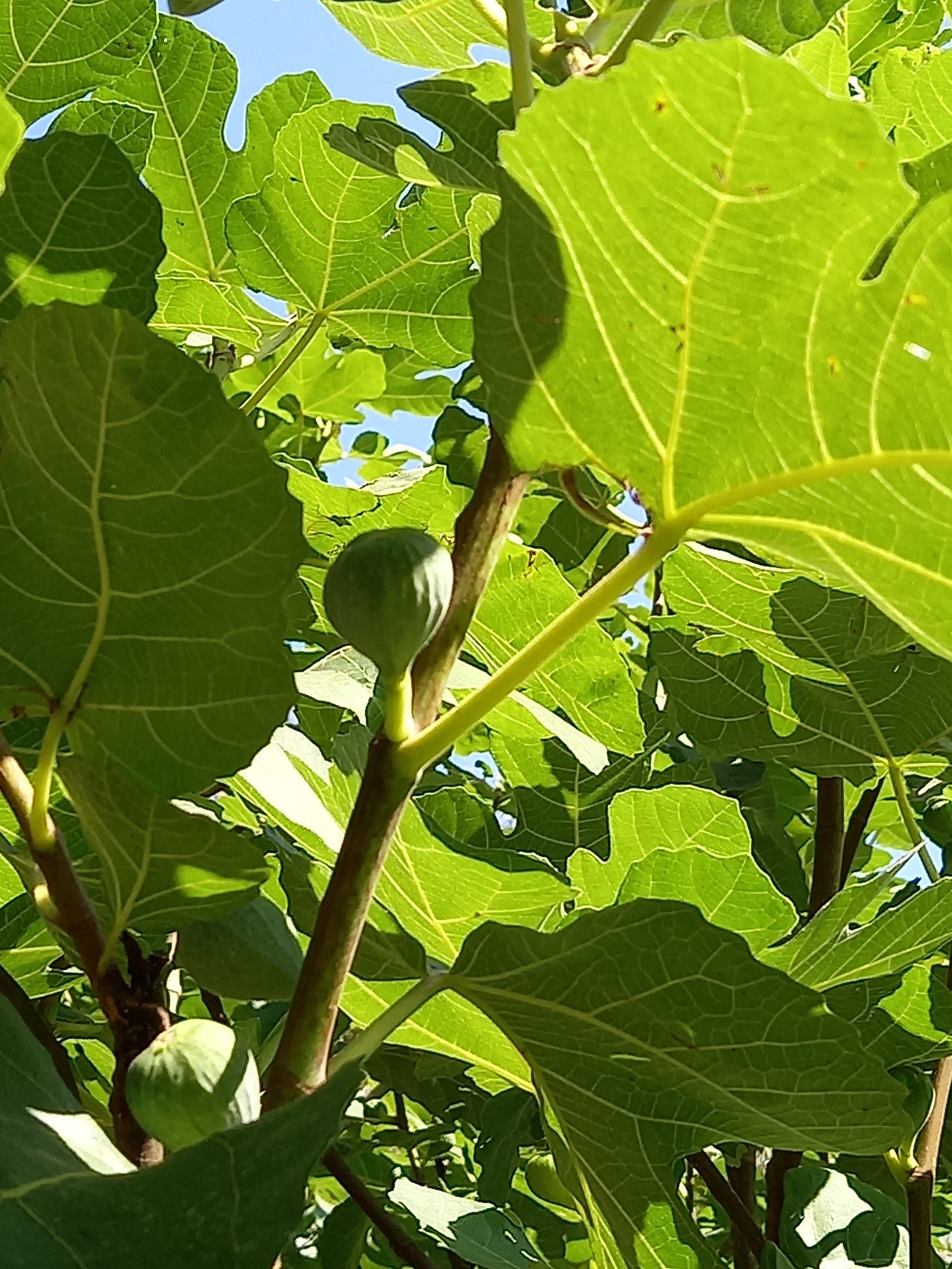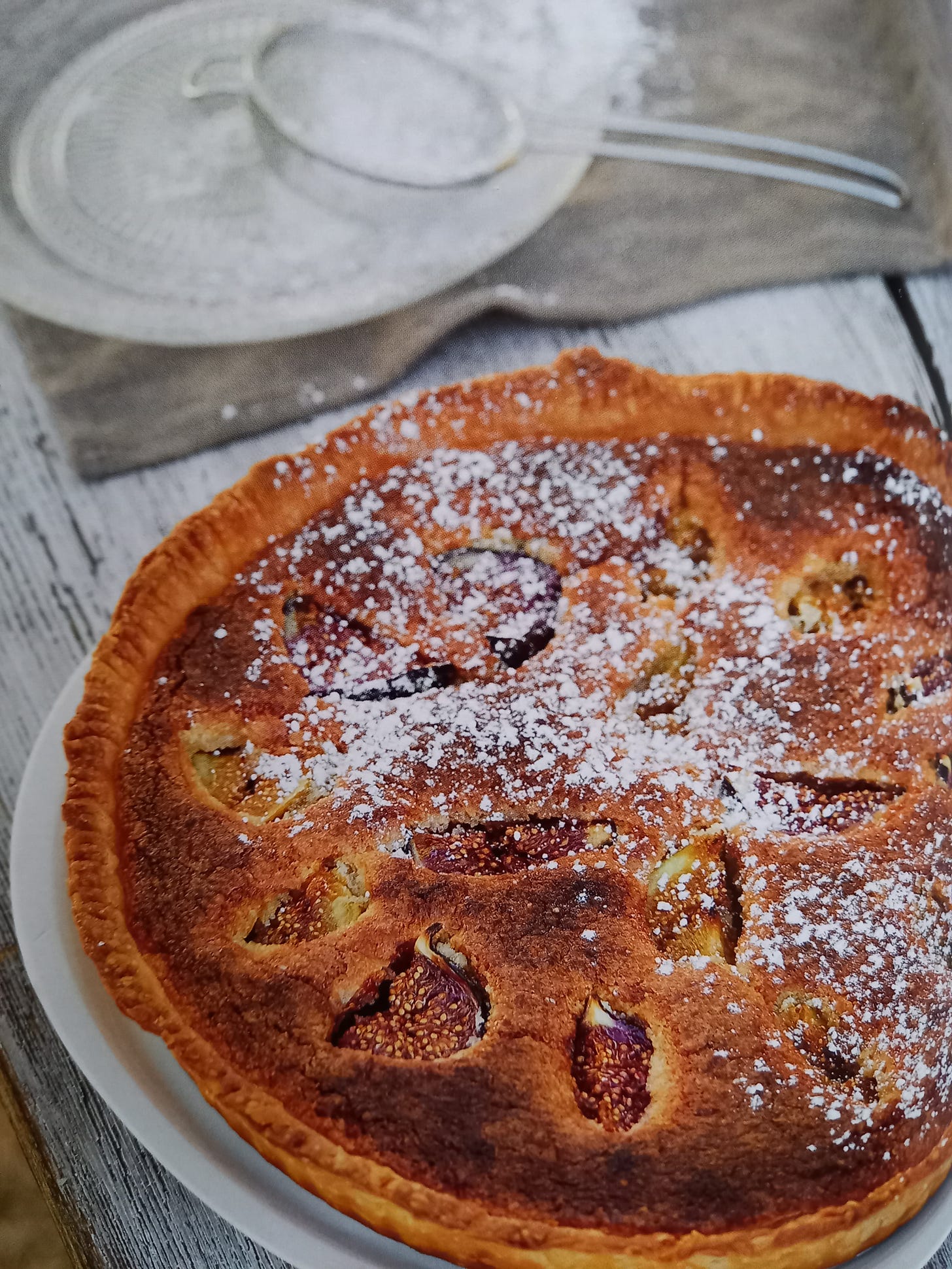Struggling with Salman Rushdie? Eat figs.
A recipe for Fig frangipane tart
We’re coming again into fig season. Which makes it the time of year for another grapple with Salman Rushdie.
I’m a little ashamed to admit to it, but I’ve read the first few pages of each of his novels several times over but have never managed to penetrate the rest. Figs help because I’m so passionate about them, I will gobble up 15 at one go. A fig of around 40g/1 1⁄4 ounces also weighs in at approximately 30 calories. But not many of those calories have time to hang about. After a brief period of digestion, 15 figs will rush straight through you. Which makes for a series of 2 a.m. visits to the bathroom. Painless visits, but a good time to tackle Salman Rushdie one more time without distraction.
It's the high lignin content of figs that causes their instability. Lignin is an indigestible food fibre. It’s this that turns them, more than any other common fruit or vegetable, into a laxative, although I would strongly recommend you don’t include an artichoke in any meal that features figs.
While EU regulations don’t permit a bottle of syrup of figs to be designated a laxative, perhaps figs should be listed on cigarette boxes. For people with reduced nicotine tolerance, smoking can have a laxative effect. Fig extract is one of the many unexpected additives used in tobacco. Maybe it’s this that triggers it?
Figs also contain tryptophan which promotes sleep. But of course when you've eaten enough of them, their laxative effect will keep you awake. The fig’s medical properties continue: they and their leaves have been found effective in controlling eczema, psoriasis and vitiligo. Even more constructively, they apparently contain chemicals that, along with the fruit, appear to reduce high cholesterol and increase diabetics’ ability to process insulin. Then there’s the tree’s sap: some people swear by it to treat warts.
As reported in the Bible’s Book of Genesis, sartorially, too, they have achieved popularity. Having guzzled from the tree of knowledge of good and evil, Adam and Eve, first fashion influencers, slapped the leaves over their suddenly-discovered nakedness. Shy statues followed suit.
If Tabled has revealed just how ancient are so many of our common vegetables and fruits, possibly none is as old as the fig.
In the early Neolithic archaeological site of Gilgal I, 13k/9 miles north of Jericho in the Jordan Valley, nine sub-fossil figs were found, dating to around 9400-9200 BC. That’s about 1000 years before evidence of the domestication of wheat, and barley, and legumes. Pollinated by the burrowing Agaonidae fig wasp, while the self-fertilising fig produces fruits on its own, it is a reproductive ‘dead-end’ tree that can only be propagated by shoots of the variant strain being planted over and over. Which suggests the fig represents the first known instance of agriculture.
Far later down the line, fig cultivation in Greece was mentioned by Aristotle and Theophrastus. Aristotle was precise enough to describe how the cultivated fruit depended on the wild fig to pollinate it and also noted the crucial work of fig wasps. (See the previous para…These details are for fellow 2 a.m. victims to take up and investigate.)
Cato the Elder identified several strains of fig in ancient Rome, where they were often used to fatten geese for an early version of foie gras. Livia (Mrs Emperor Augustus) poisoned her husband by smearing his figs with venom.
Fig domestication didn’t stand still. They were cultivated from Afghanistan and India all the way to Portugal. In the 16th century, it was introduced to the gardens of London’s Lambeth Palace by Cardinal Pole, who returned from Rome as papal legate on the accession of Mary I in order to readmit England to the Catholic Church. (More stuff to check out at 2 a.m.) By 1769, figs had reached California, the trees brought by Spanish missionairies, hence the local name Mission fig.
The contemptuous “I don’t give a fig” is translated from a Spanish insult - yet another one centred on debasing women. It's a pun on the Iberian word for fig ‘higo’, ‘higa’ meaning female genitalia. Spaniards indicated their disdain by shoving their thumb between their first and second fingers, a derisory visual representation whose modern equivalent is the less offensive V sign. The gesture, common in Shakespeare’s time, was known as The Fig of Spain.
If you’re a fig fanatic like me, the prospect of another broken night’s sleep is not enough to prevent you from buying figs the very next day, and the next, and the next, until the season for the fruit is over.
But don’t just stand at the kitchen counter guzzling them. Use them widely in cooking. They have a remarkable capacity for marrying with salty ingredients as much as sweet ones, as a salad of quartered ripe fig with Parma ham, torn mozzarella and rocket/arugula demonstrates. While a warm open fig tarte is a wonderful way to end a meal, served with a bowl of crème fraîche, (though not cooked as long as I did here)
figs go well with roast loin of pork, added half way through to bake in the juices of the meat. Another asset of the fig is that the protein-digesting enzymes it contains break down muscle and connective tissue, so they will tenderise any meat they are cooked with.
Tarte Bourdaloue is an almond frangipane tart from the Périgord in South West France, embedded with slices of pear. This recipe exchanges the pear for figs, which grow in wild profusion across that region. It’s also good with apricots. Or raspberries.
Serves 6-8
For the pastry, if you want to make your own (shop-bought is perfectly fine)
250g/8 oz plain flour
50g/2 oz icing sugar
125g/4½ oz unsalted butter, chilled and cut into cubes
1 egg, lightly beaten
For the filling
100g/3 ½ oz unsalted butter, softened
100g/3 ½ oz caster sugar
1 egg, lightly beaten
100g/3½ oz ground almonds
1 teaspoon almond essence (optional)
4-6 figs, quartered
Icing sugar for dusting
To make the pastry, sieve the flour and icing sugar together. Rub the chilled cubes of butter into flour until it becomes sandy in texture, then stir in the egg and bring the mix together. Wrap in cling film and chill for at least 30 minutes.
To make the filling, blend together the butter and sugar until fluffy. Gradually add the egg, ground almonds and almond essence, and mix into a paste. This can all be done in a food processor. Chill 30 minutes.
Preheat oven 200C/400F.
Roll out the pastry and set into a large well-buttered tart tin. Scrape in the frangipane and smooth it out. Lightly press the fig quarters into it. Dust with icing sugar and bake in the oven for 30 minutes until golden brown (but not quite as brown as in the photo!) and firm on the outside but slightly soft in the middle. When cooled, dust with a little more icing sugar to serve.
Find more newsletters with opinions and recipes here. If you want to take issue, please Comment.




Julia, thanks for another great recipe. The tart sounds delicious. As for its provenance, however, Tarte Bourdaloue may well have made its way to the Périgord but it originated in Paris, at a patisserie on the Rue Bourdaloue in the ninth arrondissement. According to Wikipedia, tarte Bourdaloue was invented in the 1850s by a pastry chef named Monsieur Fasquelle whose shop was on that street. According to lore, Proust was a fan. I discovered this tart (the pear version, not the fig) back in the 1970s when a man who was courting me brought one over in what turned out to be a successful attempt at seduction. I've been in love with it ever since...
I love everything about figs. Their flavour, their colour, their sensuous shape. But so do the wasps. Fortunately, we've managed a compromise. The wasps let me gorge myself silly until I can't stomach any more then I buzz off and they have their share.